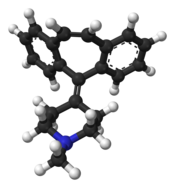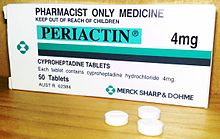Cyproheptadine
 | |
 | |
| Clinical data | |
|---|---|
| Pronunciation | /ˌsaɪproʊˈhɛptədiːn/[1] |
| Trade names | Periactin, others |
| AHFS/Drugs | Monograph |
| MedlinePlus | a682541 |
| License data | |
| Pregnancy category |
|
| Routes of administration | Oral |
| ATC code | |
| Legal status | |
| Legal status |
|
| Pharmacokineticdata | |
| Protein binding | 96 to 99% |
| Metabolism | Liver,[3][4]mostlyCYP3A4mediated. |
| Eliminationhalf-life | 8.6 hours[2] |
| Excretion | Faecal (2–20%; of which, 34% as unchanged drug) andrenal(40%; none as unchanged drug)[3][4] |
| Identifiers | |
| |
| CAS Number | |
| PubChemCID | |
| IUPHAR/BPS | |
| DrugBank | |
| ChemSpider | |
| UNII | |
| KEGG | |
| ChEBI | |
| ChEMBL | |
| CompTox Dashboard(EPA) | |
| ECHA InfoCard | 100.004.482 |
| Chemical and physical data | |
| Formula | C21H21N |
| Molar mass | 287.406g·mol−1 |
| 3D model (JSmol) | |
| |
| |
| (verify) | |
Cyproheptadine,sold under the brand namePeriactinamong others, is afirst-generationantihistaminewith additionalanticholinergic,antiserotonergic,andlocal anestheticproperties.
It was patented in 1959 and came into medical use in 1961.[5]In 2021, it was the 280th most commonly prescribed medication in the United States, with more than 800,000 prescriptions.[6][7]
Medical uses
[edit]

Cyproheptadine is used to treat allergic reactions (specificallyhay fever).[8]There is evidence supporting its use for allergies, but second generation antihistamines such asketotifenandloratadinehave shown equal results with fewer side effects.[9]
It is also used as a preventive treatment againstmigraine.In a 2013 study the frequency of migraine was dramatically reduced in patients within 7 to 10 days after starting treatment. The average frequency of migraine attacks in these patients before administration was 8.7 times per month, this was decreased to 3.1 times per month at 3 months after the start of treatment.[9][10]This use is on the label in the UK and some other countries.
It is also used off-label in the treatment ofcyclical vomiting syndromein infants; the only evidence for this use comes from retrospective studies.[11]
Cyproheptadine is sometimes used off-label to improveakathisiain people on antipsychotic medications.[12]
It is used off-label to treat various dermatological conditions, includingpsychogenic itch,[13]drug-inducedhyperhidrosis(excessive sweating),[14]and prevention of blister formation for some people withepidermolysis bullosa simplex.[15]
One of the effects of the drug is increasedappetiteand weight gain, which has led to its use (off-label in the USA) for this purpose in children who are wasting as well as people withcystic fibrosis.[16][17][18][19]
It is also used off-label in the management of moderate to severe cases ofserotonin syndrome,a complex of symptoms associated with the use ofserotonergicdrugs, such asselective serotonin reuptake inhibitors(andmonoamine oxidase inhibitors), and in cases of high levels of serotonin in the blood resulting from a serotonin-producingcarcinoidtumor.[20][21]
Cyproheptadine has sedative effects and can be used to treat insomnia similarly to other centrally-acting antihistamines.[22][23][24][25]The recommended dose for this use is 4 to 8 mg.[23]
Adverse effects
[edit]Adverse effects include:[3][4]
- Sedation and sleepiness (often transient)
- Dizziness
- Disturbed coordination
- Confusion
- Restlessness
- Excitation
- Nervousness
- Tremor
- Irritability
- Insomnia
- Paresthesias
- Neuritis
- Convulsions
- Euphoria
- Hallucinations
- Hysteria
- Faintness
- Allergic manifestation of rash and edema
- Diaphoresis
- Urticaria
- Photosensitivity
- Acute labyrinthitis
- Diplopia (seeing double)
- Vertigo
- Tinnitus
- Hypotension (low blood pressure)
- Palpitation
- Extrasystoles
- Anaphylactic shock
- Hemolytic anemia
- Blood dyscrasias such asleukopenia,agranulocytosisandthrombocytopenia
- Cholestasis
- Hepatic (liver) side effects such as:
- Hepatitis
- Jaundice
- Liver failure[26]
- Hepatic function abnormality
- Epigastricdistress
- Anorexia
- Nausea
- Vomiting
- Diarrhea
- Anticholinergicside effects such as:
- Blurred vision
- Constipation
- Xerostomia (dry mouth)
- Tachycardia (high heart rate)
- Urinary retention
- Difficulty passing urine
- Nasal congestion
- Nasal or throat dryness
- Urinary frequency
- Early menses
- Thickening of bronchial secretions
- Tightness of chest and wheezing
- Fatigue
- Chills
- Headache
- Increased appetite
- Weight gain
Overdose
[edit]Gastric decontamination measures such asactivated charcoalare sometimes recommended in cases of overdose. The symptoms are usually indicative of CNS depression (or conversely CNS stimulation in some) and excess anticholinergic side effects. TheLD50in mice is 123 mg/kg and 295 mg/kg in rats.[3][4]
Pharmacology
[edit]Pharmacodynamics
[edit]| Site | Ki(nM)[a] | Action[b] | Species | Ref. |
|---|---|---|---|---|
| H1 | 0.06 | ↓ | Human | |
| H2 | ND | ND | ||
| H3 | >10,000 | Human | ||
| H4 | 202 | Human | ||
| M1 | 12 | ↓ | Human | |
| M2 | 7 | ↓ | Human | |
| M3 | 12 | ↓ | Human | |
| M4 | 8 | ↓ | Human | |
| M5 | 11.8 | ↓ | Human | |
| 5-HT1A | 59 | ↓ | Human | |
| 5-HT2A | 1.67 | ↓ | Human | |
| 5-HT2B | 1.54 | ↓ | Human | |
| 5-HT2C | 2.23 | ↓ | Human | |
| 5-HT3 | 228 | Mouse | ||
| 5-HT6 | 142 | Human | ||
| 5-HT7 | 123 | Human | ||
| D1 | 117 | Human | ||
| D2 | 112 | ↓ | Human | |
| D3 | 8 | Human | ||
| SERT | 4,100 | Rat | ||
| NET | 290 | Rat | ||
| DAT | ND | ND | ||
| ||||
Cyproheptadine is a very potentantihistamineorinverse agonistof theH1receptor.At higher concentrations, it also hasanticholinergic,antiserotonergic,andantidopaminergicactivities. Of theserotonin receptors,it is an especially potent antagonist of the5-HT2receptors.This is thought to underlie its effectiveness in the treatment ofserotonin syndrome.[28]However, it is possible that blockade of5-HT1receptorsmay also contribute to its effectiveness in serotonin syndrome.[29]Cyproheptadine has been reported to block 85% of 5-HT2receptors in the human brain at a dose of 4 mg three times per day (12 mg/day total) and to block 95% of 5-HT2receptors in the human brain at a dose of 6 mg three times per day (18 mg/day total) as measured withpositron emission tomography(PET).[30]The dose of cyproheptadine recommended to ensure blockade of the 5-HT2receptors for serotonin syndrome is 20 to 30 mg.[28]Besides its activity atneurotransmittertargets, cyproheptadine has been reported to possess weakantiandrogenicactivity.[31]
Pharmacokinetics
[edit]Cyproheptadine is well-absorbed followingoral ingestion,with peak plasma levels occurring after 1 to 3 hours.[32]Itsterminal half-lifewhen taken orally is approximately 8 hours.[2]
Chemistry
[edit]Cyproheptadine is atricyclicbenzocyclohepteneand is closely related topizotifenandketotifenas well as totricyclic antidepressants.
Research
[edit]Cyproheptadine was studied in one small trial as an adjunct in people withschizophreniawhose condition was stable and were on other medication; while attention and verbal fluency appeared to be improved, the study was too small to draw generalizations from.[33]It has also been studied as an adjuvant in two other trials in people with schizophrenia, around fifty people overall, and did not appear to have an effect.[34]
There have been some trials to see if cyproheptadine could reduce sexual dysfunction caused by SSRI and antipsychotic medications.[35]
Cyproheptadine has been studied for the treatment ofpost-traumatic stress disorder.[34]
Veterinary use
[edit]Cyproheptadine is used in cats as anappetite stimulant[36][37]: 1371 and as an adjunct in the treatment ofasthma.[38]Possible adverse effects include excitement and aggressive behavior.[39]Theelimination half-lifeof cyproheptadine in cats is 12 hours.[38]
Cyproheptadine is a second line treatment forpituitary pars intermedia dysfunctionin horses.[40][41]
References
[edit]- ^"Cyproheptadine".Dictionary Unabridged(Online). n.d.
- ^abGunja N, Collins M, Graudins A (2004). "A comparison of the pharmacokinetics of oral and sublingual cyproheptadine".Journal of Toxicology. Clinical Toxicology.42(1): 79–83.doi:10.1081/clt-120028749.PMID15083941.S2CID20196551.
- ^abcd"Cyproheptadine Hydrochloride tablet [Boscogen, Inc.]"(PDF).DailyMed.U.S. National Library of Medicine. November 2010.Retrieved26 October2013.
- ^abcd"Product Information: Periactin (cyproheptadine hydrochloride)"(PDF).Aspen Pharmacare Australia.Aspen Pharmacare Australia Pty Ltd. 17 November 2011. Archived fromthe original(PDF)on 29 October 2013.Retrieved26 October2013.
- ^Fischer J, Ganellin CR (2006).Analogue-based Drug Discovery.John Wiley & Sons. p. 547.ISBN9783527607495.
- ^"The Top 300 of 2021".ClinCalc.Archivedfrom the original on 15 January 2024.Retrieved14 January2024.
- ^"Cyproheptadine - Drug Usage Statistics".ClinCalc.Retrieved14 January2024.
- ^"Cyproheptadine".MedlinePlus Drug Information.U.S. National Library of Medicine.
- ^abDe Bruyne P, Christiaens T, Boussery K, Mehuys E, Van Winckel M (January 2017). "Are antihistamines effective in children? A review of the evidence".Archives of Disease in Childhood.102(1): 56–60.doi:10.1136/archdischild-2015-310416.PMID27335428.S2CID21185048.
- ^Saito Y, Yamanaka G, Shimomura H, Shiraishi K, Nakazawa T, Kato F, et al. (May 2017). "Reconsideration of the diagnosis and treatment of childhood migraine: A practical review of clinical experiences".Brain & Development.39(5): 386–394.doi:10.1016/j.braindev.2016.11.011.PMID27993427.S2CID34703034.
- ^Salvatore S, Barberi S, Borrelli O, Castellazzi A, Di Mauro D, Di Mauro G, et al. (July 2016)."Pharmacological interventions on early functional gastrointestinal disorders".Italian Journal of Pediatrics.42(1): 68.doi:10.1186/s13052-016-0272-5.PMC4947301.PMID27423188.
- ^Taylor DM, Paton C, Kapur S (2015).The Maudsley Prescribing Guidelines in Psychiatry.John Wiley & Sons. p. 85.ISBN978-1-118-75457-3.
- ^Szepietowski JC, Reszke R (2016). "Psychogenic Itch Management".Current Problems in Dermatology.50:124–132.doi:10.1159/000446055.ISBN978-3-318-05888-8.PMID27578081.
- ^Ashton AK, Weinstein WL (May 2002). "Cyproheptadine for drug-induced sweating".The American Journal of Psychiatry.159(5): 874–875.doi:10.1176/appi.ajp.159.5.874-a.PMID11986151.
- ^So JY, Teng J (1993)."Epidermolysis Bullosa Simplex".In Adam MP, Everman DB, Mirzaa GM, Pagon RA, Wallace SE, Bean LJ, Gripp KW, Amemiya A (eds.).GeneReviews.University of Washington, Seattle.PMID20301543.
- ^"Ciproheptadina, estimulante del apetito"[Cyproheptadine, appetite stimulant].vademecum.es(in Spanish).
- ^"Bioplex NF".Archived fromthe originalon 18 April 2018.Retrieved18 April2018.
- ^Harrison ME, Norris ML, Robinson A, Spettigue W, Morrissey M, Isserlin L (June 2019). "Use of cyproheptadine to stimulate appetite and body weight gain: A systematic review".Appetite.137:62–72.doi:10.1016/j.appet.2019.02.012.PMID30825493.S2CID72333631.
- ^Kim SY, Yun JM, Lee JW, Cho YG, Cho KH, Park YG, Cho B (October 2021). "Efficacy and Tolerability of Cyproheptadine in Poor Appetite: A Multicenter, Randomized, Double-blind, Placebo-controlled Study".Clinical Therapeutics.43(10): 1757–1772.doi:10.1016/j.clinthera.2021.08.001.PMID34509304.S2CID237493456.
- ^Rossi S, ed. (2013).Australian Medicines Handbook(2013 ed.). Adelaide: The Australian Medicines Handbook Unit Trust.ISBN978-0-9805790-9-3.
- ^Iqbal MM, Basil MJ, Kaplan J, Iqbal MT (November 2012). "Overview of serotonin syndrome".Annals of Clinical Psychiatry.24(4): 310–318.PMID23145389.
- ^Badr B, Naguy A (October 2022)."Cyproheptadine:a psychopharmacological treasure trove? ".CNS Spectrums.27(5): 533–535.doi:10.1017/S1092852921000250.PMID33632345.
- ^abEkambaram V, Owens J (January 2021). "Medications Used for Pediatric Insomnia".Child and Adolescent Psychiatric Clinics of North America.30(1): 85–99.doi:10.1016/j.chc.2020.09.001.PMID33223070.S2CID227131545.
- ^Rombaut NE (1995).Antihistamines and Sedation: Methods and Measures(Thesis).OCLC59660401.ProQuest301570569.
- ^Wanderer AA, St Pierre JP, Ellis EF (October 1977). "Primary acquired cold urticaria. Double-blind comparative study of treatment with cyproheptadine, chlorpheniramine, and placebo".Archives of Dermatology.113(10): 1375–1377.doi:10.1001/archderm.113.10.1375.PMID334082.
- ^Chertoff J, Alam S, Clark V (July 2014)."Cyproheptadine-Induced Acute Liver Failure".ACG Case Reports Journal.1(4): 212–213.doi:10.14309/crj.2014.56.PMC4286888.PMID25580444.
- ^Roth BL,Driscol J."PDSP KiDatabase ".Psychoactive Drug Screening Program (PDSP).University of North Carolina at Chapel Hill and the United States National Institute of Mental Health.Retrieved14 August2017.
- ^abGillman PK (1999)."The serotonin syndrome and its treatment".Journal of Psychopharmacology.13(1): 100–109.doi:10.1177/026988119901300111.PMID10221364.S2CID17640246.
- ^Sporer KA (August 1995). "The serotonin syndrome. Implicated drugs, pathophysiology and management".Drug Safety.13(2): 94–104.doi:10.2165/00002018-199513020-00004.PMID7576268.S2CID19809259.
- ^Kapur S, Zipursky RB, Jones C, Wilson AA, DaSilva JD, Houle S (June 1997). "Cyproheptadine: a potent in vivo serotonin antagonist".The American Journal of Psychiatry.154(6): 884a–884.doi:10.1176/ajp.154.6.884a.PMID9167527.
- ^Pucci E, Petraglia F (December 1997). "Treatment of androgen excess in females: yesterday, today and tomorrow".Gynecological Endocrinology.11(6): 411–433.doi:10.3109/09513599709152569.PMID9476091.
- ^Murray L, Daly F, McCoubrie DM, Cadogan M (15 January 2011).Toxicology Handbook.Elsevier Australia. p. 388.ISBN978-0-7295-3939-5.Retrieved27 November2011.
- ^Buoli M, Altamura AC (March 2015). "May non-antipsychotic drugs improve cognition of schizophrenia patients?".Pharmacopsychiatry.48(2): 41–50.doi:10.1055/s-0034-1396801.PMID25584772.S2CID19202816.
- ^abDabaghzadeh F, Khalili H, Ghaeli P, Dashti-Khavidaki S (December 2012). "Potential benefits of cyproheptadine in HIV-positive patients under treatment with antiretroviral drugs including efavirenz".Expert Opinion on Pharmacotherapy.13(18): 2613–2624.doi:10.1517/14656566.2012.742887.PMID23140169.S2CID25769557.
- ^Nunes LV, Moreira HC, Razzouk D, Nunes SO, Mari J (2012). "Strategies for the treatment of antipsychotic-induced sexual dysfunction and/or hyperprolactinemia among patients of the schizophrenia spectrum: a review".Journal of Sex & Marital Therapy.38(3): 281–301.doi:10.1080/0092623X.2011.606883.PMID22533871.S2CID23406005.
- ^Agnew W, Korman R (September 2014)."Pharmacological appetite stimulation: rational choices in the inappetent cat".Journal of Feline Medicine and Surgery.16(9): 749–756.doi:10.1177/1098612X14545273.PMC11185246.PMID25146662.S2CID37126352.
- ^Gupta RC, ed. (2012).Veterinary Toxicology: Basic and Clinical Principles(2 ed.).AmsterdamBoston:Academic Press.pp. xii+1438.ISBN978-0-12-385926-6.OCLC794491298.
- ^abDowling PM (8 February 2005)."Systemic Therapy of Airway Disease: Cyproheptadine".In Kahn CM, Line S, Aiello SE (eds.).The Merck Veterinary Manual(9th ed.).John Wiley & Sons.ISBN978-0-911910-50-6.Retrieved on 26 October 2008.
- ^Dowling PM (8 February 2005)."Drugs Affecting Appetite".In Kahn CM, Line S, Aiello SE (eds.).The Merck Veterinary Manual(9th ed.).John Wiley & Sons.ISBN978-0-911910-50-6.Retrieved on 26 October 2008.
- ^Durham AE (April 2017). "Therapeutics for Equine Endocrine Disorders".The Veterinary Clinics of North America. Equine Practice.33(1): 127–139.doi:10.1016/j.cveq.2016.11.003.PMID28190613.
- ^Kritchevsky JE (July 2019)."Hirsutism Associated with Adenomas of the Pars Intermedia".Merck Vet Manual.Retrieved24 April2011.
